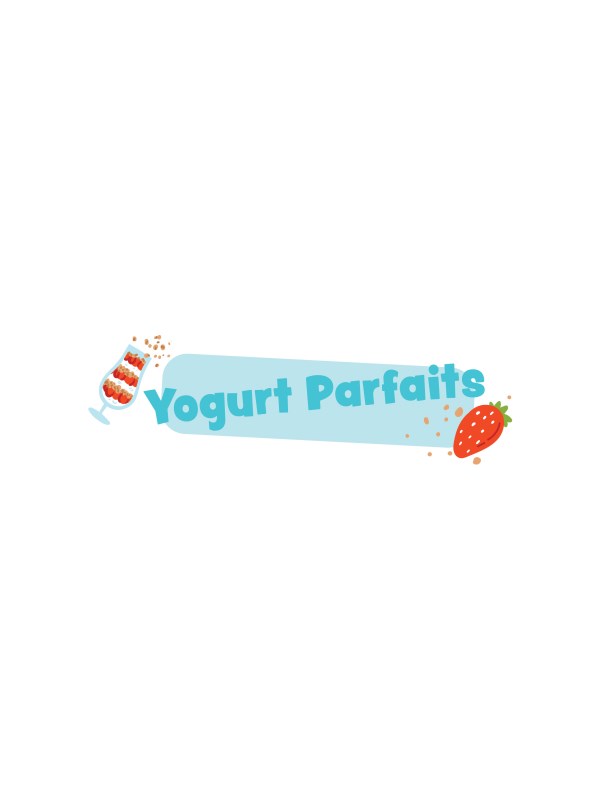
Cranberry-Almond No-Bake Energy Bites
After-School Peanut Butter Cookies
Make It Your Way Challenge: Sandwiches
Make It Your Way Challenge: Get Salty
Make It Your Way Challenge: Food Texture Mix and Match
Make It Your Way Challenge: Cheese Snack Plate

 SERVES 2
SERVES 2
TOTAL TIME 15 minutes
Greek yogurt makes the creamiest parfait, but you can use regular plain yogurt instead. Regular yogurt is thinner than Greek yogurt (extra liquid has been drained from Greek yogurt so that it’s really thick and creamy), so the layers may not stay as well defined.
Prepare Ingredients
1 cup plain Greek yogurt
1 tablespoon honey
1 cup raspberries, blueberries, blackberries, and/or sliced strawberries
½ cup granola
Gather Cooking Equipment
Small bowl
Whisk
Spoon
Two 8-ounce glasses
¼-cup dry measuring cup
1-tablespoon measuring spoon
 Start Cooking!
Start Cooking!
1 In small bowl, whisk yogurt and honey until smooth. Spoon one-quarter of the yogurt-honey mixture into each glass. Top with ¼ cup berries, followed by 2 tablespoons granola.
2 Repeat layering process with remaining yogurt-honey mixture, berries, and granola. When you’re done, you should have 2 layers each of yogurt-honey mixture, berries, and granola. Serve within 15 minutes or granola will start to become soggy.

Food for Thought
What makes Greek yogurt different from regular yogurt? Let’s find out!
If you’ve got some regular plain yogurt and some plain Greek yogurt in your refrigerator, conduct a taste test. Observe both varieties, stir them with a spoon, and take a taste. What do you notice about each type of yogurt? What’s its texture like? Its flavor?
Greek yogurt is made the same way that regular yogurt is made—just with an extra step at the end: Greek yogurt is strained for several hours, usually in cheesecloth (a woven fabric with holes in it). As the yogurt sits in the cheesecloth, a clear liquid called whey (pronounced “way”) drains out. This makes Greek yogurt thicker and creamier than regular yogurt. Whey is made of water and proteins (called whey proteins)—not to worry, though, there are still plenty of proteins in the Greek yogurt that’s left behind.
You can try making your own Greek yogurt at home! Here’s how to do it.
1 Line fine-mesh strainer with 2 layers of cheesecloth or 3 basket-style coffee filters. Set strainer inside medium bowl.
2 Add regular yogurt to cheesecloth-lined strainer. Cover strainer and bowl with plastic wrap and place in refrigerator for at least 8 hours or up to 24 hours.
3 Remove strainer and bowl from refrigerator. Transfer Greek yogurt from strainer to an airtight container and store in the refrigerator for up to 1 week.
4 Try a taste test! Eat some of your Greek yogurt (you can taste the whey, too!). What do you notice about its flavor? Its texture? How is it different from regular yogurt? How is it the same?
Do not use yogurt containing modified food starch, gelatin, or ingredients called “gums” for this activity.
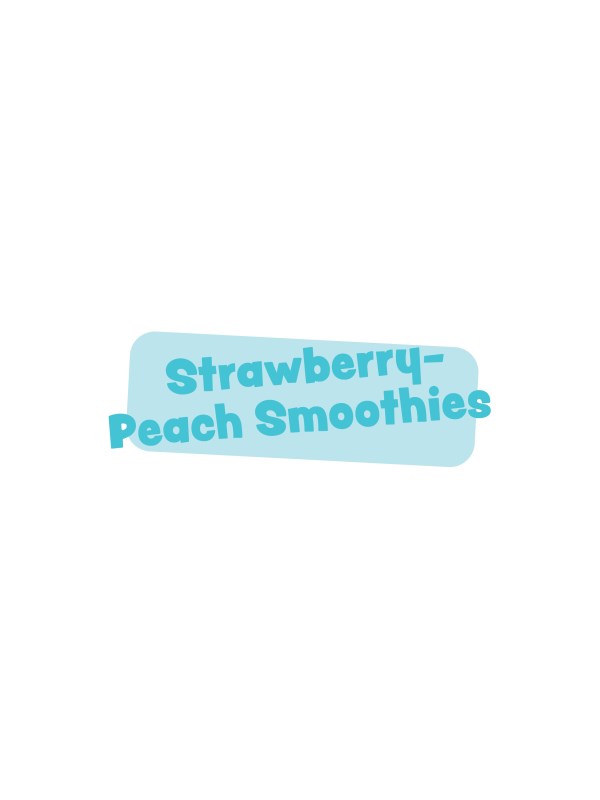
 SERVES 2
SERVES 2
TOTAL TIME 10 minutes
Colorful, creamy, and supersmooth—these smoothies will make a fruity part of your breakfast, lunch, or snack!
Prepare Ingredients
1 ripe banana, peeled and broken into 4 pieces
1 tablespoon honey
1 cup frozen strawberries
1 cup frozen peaches
1 cup plain yogurt
¼ cup orange juice
Gather Cooking Equipment
Blender
Dish towel
Rubber spatula
2 glasses
 Start Cooking!
Start Cooking!
1 Place banana and honey in blender. Put lid on top of blender and hold lid firmly in place with folded dish towel. Process until smooth, about 10 seconds.
2 Stop blender. Add strawberries, peaches, yogurt, and orange juice. Replace lid and process for 30 seconds. Stop blender and scrape down sides of blender jar with rubber spatula.
3 Replace lid and continue to process until smooth, about 30 seconds longer. Pour into glasses and serve.


Food for Thought
Once you master smoothie basics, the combinations are endless. Frozen fruit keeps things cold. If you have fresh fruit, place it in the freezer before you go to bed—voilà, frozen fruit.
Primary Colors

Secondary Colors: Make by mixing two primary colors



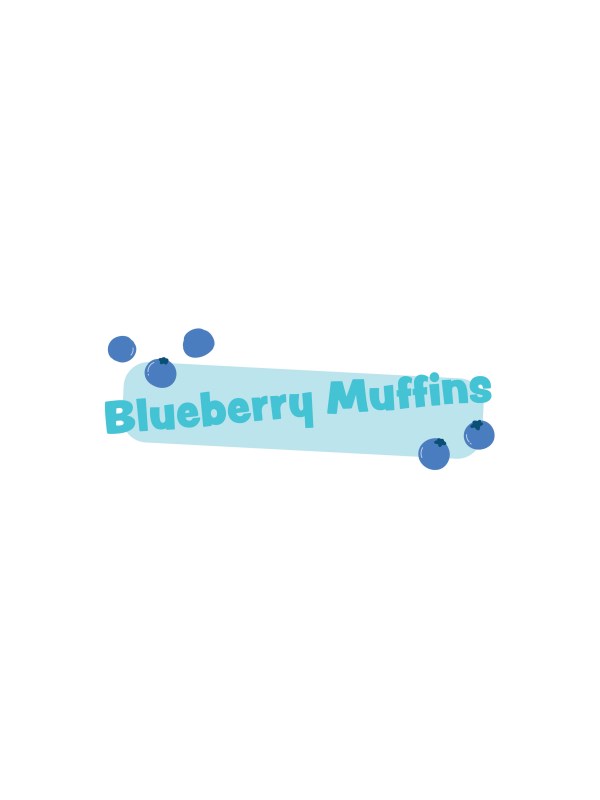

 MAKES 12 muffins
MAKES 12 muffins
TOTAL TIME 55 minutes, plus cooling time
If using frozen berries, do not thaw.
Prepare Ingredients
Vegetable oil spray
3 cups (15 ounces) plus 1 tablespoon all-purpose flour, measured separately
1 cup (7 ounces) sugar
1 tablespoon baking powder
½ teaspoon baking soda
½ teaspoon salt
1½ cups plain yogurt
2 large eggs
8 tablespoons unsalted butter, melted and cooled
1½ cups fresh or frozen blueberries
Gather Cooking Equipment
12-cup muffin tin
3 bowls (1 large, 1 medium, 1 small)
Whisk
Rubber spatula
⅓-cup dry measuring cup
Toothpick
Oven mitts
Cooling rack
 Start Cooking!
Start Cooking!
1 Adjust oven rack to middle position and heat oven to 375 degrees. Spray 12-cup muffin tin with vegetable oil spray.
2 In large bowl, whisk together 3 cups flour, sugar, baking powder, baking soda, and salt. In medium bowl, whisk yogurt and eggs until smooth.
3 Add yogurt mixture to large bowl with flour mixture and use rubber spatula to stir gently until just combined and no dry flour is visible. Gently stir in melted butter.
4 In small bowl, toss blueberries with remaining 1 tablespoon flour. Gently stir blueberries into batter. Do not overmix.
5 Use ⅓-cup dry measuring cup to divide batter evenly among muffin cups.
6 Place muffin tin in oven and bake until golden brown and toothpick inserted in center of muffin comes out clean, 20 to 25 minutes.
7 Use oven mitts to remove muffin tin from oven (ask an adult for help). Place muffin tin on cooling rack and let muffins cool in tin for 15 minutes.
8 Using your fingertips, gently wiggle muffins to loosen from muffin tin and transfer to cooling rack. Let cool for at least 10 minutes before serving.

Food for Thought
Blueberries are berries…right?! Well, hold on. Before we say yes or no, let’s do some investigation. Start by setting aside a few extra blueberries before you start cooking. When the muffins are baking in step 6, take a moment to observe those extra blueberries. What do they look like?
Next, cut them in half across their equator (or ask an adult for help) and take a look at their insides. Do you see any seeds?
These seeds are a key clue as to whether these berries are actually berries! Because raspberries, strawberries, and blackberries AREN’T ACTUALLY BERRIES. (Well, at least according to plant scientists they aren’t.) But blueberries are. (Phew!)
In our everyday conversations, “berries” are small fruits that grow on a bush. But, if you ask a plant scientist “What’s a berry?” they will give you a different answer: A berry is a fruit that grows from one flower and usually contains several seeds inside. Blueberries fit this scientific definition, so scientists call them “true berries.” But a single raspberry is actually made up of lots of tiny, round fruits, each with its own seed inside. Strawberries also contain many teeny individual fruits, each with their own yellow seed on the outside.
According to plant scientists, fruits such as bananas, kiwis, grapes, and even watermelons are berries, too! Each of these berries grows from its own flower and their sweet flesh surrounds tiny seeds.

 SERVES 3 to 4 (Makes 6 cups)
SERVES 3 to 4 (Makes 6 cups)
TOTAL TIME 15 minutes
Make sure to use a plain bag without any writing (colored inks are often not microwave-safe).
Prepare Ingredients
¼ cup popcorn kernels
½ teaspoon vegetable oil
1 tablespoon unsalted butter
¼ teaspoon salt
Gather Cooking Equipment
Clean brown paper lunch bag
Large microwave-safe plate
Oven mitts
Large microwave-safe bowl
Rubber spatula
 Start Cooking!
Start Cooking!
1 Place popcorn kernels in clean brown paper lunch bag. Drizzle kernels with oil. Fold over top of bag three times to seal (do not tape or staple).
2 Shake bag to coat kernels with oil, place bag on its side on large microwave-safe plate, and shake kernels into even layer in bag.
3 Place plate in microwave and cook until popping slows down to 1 or 2 pops at a time, 3 to 5 minutes. Use oven mitts to remove plate from microwave (plate will be very hot, ask an adult for help). Set aside to cool slightly.
4 Place butter in large microwave-safe bowl (big enough to hold popcorn), cover, and heat in microwave at 50 percent power until melted, 30 to 60 seconds. Use oven mitts to remove bowl from microwave.
5 Carefully open paper bag (be careful, there will be hot steam) and pour popcorn into bowl with melted butter. Use rubber spatula to toss popcorn with butter. Sprinkle with salt. Serve.

“Pop” Quiz
Did you know that popped popcorn kernels can be different shapes?
The popcorn industry categorizes popped kernels into three basic shapes: unilateral (pieces that expand in one direction), bilateral (pieces that expand in two directions), and multilateral (pieces that expand in three or more directions). The crunchiest popcorns have more unilateral pieces. Take a look at the popcorn you made. What shapes do you see?

Food for Thought
Did you know that Americans consume 13 billion quarts of popcorn annually (enough to fill almost 5,000 Olympic-size swimming pools!)? But where does popcorn come from? And what makes popcorn pop?
Popcorn is made from corn, but not the same corn that we eat as corn on the cob—that’s called sweet corn. Instead, popcorn is a different variety of corn called…POPCORN!
As for the popping, it all starts with dried popcorn kernels. The kernel has three main parts: the hull, which is like a hard shell; the germ, which is what a new corn plant would grow from; and the endosperm, which is made of starch, tiny droplets of water, and a little bit of protein. The water in the endosperm is what puts the POP in popcorn.
As the kernels heat up, the starch in the endosperm gets softer and the tiny droplets of water expand and turn into steam. When enough steam builds up inside the kernel—at around 350 degrees—the hull breaks and the kernel explodes and turns inside-out! The starch and protein on the inside burst through the hull and turn solid in the cooler air, forming the white-yellow, pillowy part of popcorn kernels.
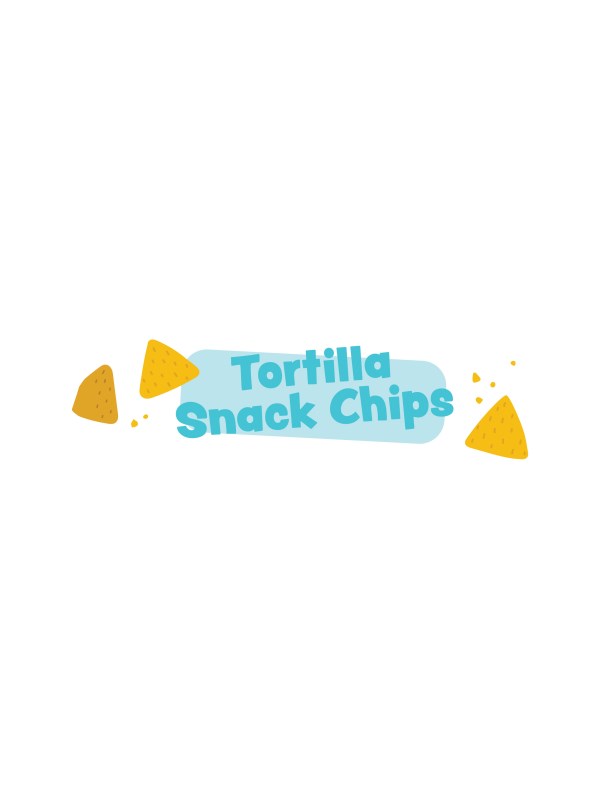

 SERVES 4
SERVES 4
TOTAL TIME 30 minutes
You can eat these chips on their own or with your favorite dips, such as hummus, guacamole, or salsa!
Prepare Ingredients
4 (8-inch) flour tortillas
Vegetable oil spray
½ teaspoon salt
Gather Cooking Equipment
Cutting board
Chef’s knife
Large bowl
2 rimmed baking sheets
Oven mitts
2 cooling racks
 Start Cooking!
Start Cooking!
1 Adjust oven racks to upper-middle and lower-middle positions and heat oven to 350 degrees.
2 Cut each tortilla into 8 wedges and transfer to large bowl. Spray wedges generously with vegetable oil spray. Sprinkle with salt. Use your hands to gently toss tortilla pieces until evenly coated on all sides. Use more cooking spray if needed.
3 Spread half of tortilla pieces onto rimmed baking sheet in single layer. Spread remaining tortilla pieces onto second rimmed baking sheet in single layer.
4 Place both baking sheets in oven and bake until chips are golden and crisp, 10 to 15 minutes. (Note that chips on lower rack may cook more quickly.)
5 Use oven mitts to remove baking sheets from oven (ask an adult for help). Place baking sheets on cooling racks and let chips cool for 10 minutes. Serve.

Food for Thought
In step 2 of this recipe, you need to cut the round tortillas into 8 equal wedges. Making the wedges the same size helps the chips bake evenly.
Which tortilla below is divided into 8 equal wedges?

While your tortilla chips bake, solve these tortilla fraction problems:

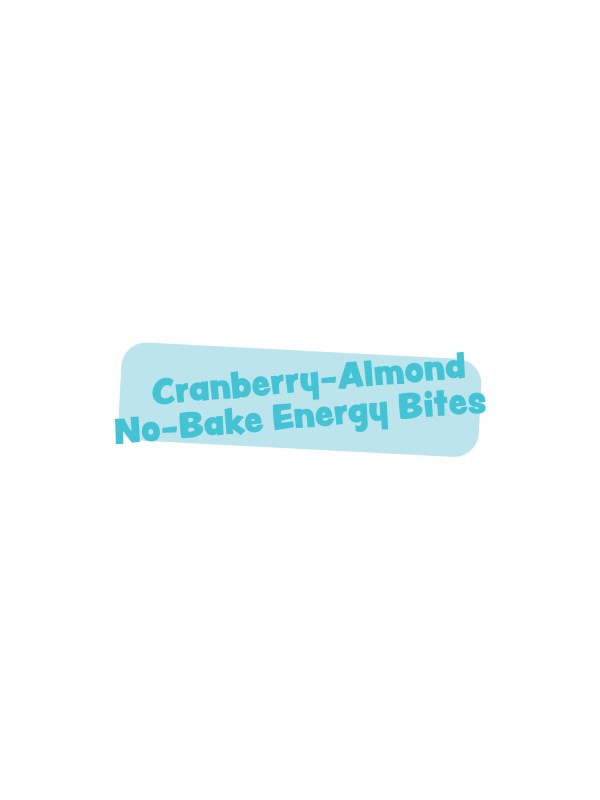
 MAKES 12 bites
MAKES 12 bites
TOTAL TIME 15 minutes, plus 30 minutes chilling time
You can add 1 tablespoon of chia seeds or ground flaxseed to oat mixture in step 1, if desired.
Prepare Ingredients
¾ cup (2¼ ounces) old-fashioned rolled oats
⅓ cup creamy peanut, almond, or sunflower butter
⅓ cup sliced almonds
⅓ cup dried cranberries
2 tablespoons honey
⅛ teaspoon salt
Gather Cooking Equipment
Large bowl
Rubber spatula
1-tablespoon measuring spoon
Plate
Plastic wrap
 Start Cooking!
Start Cooking!
1 In large bowl, combine all ingredients. Use rubber spatula to stir until well combined.
2 Use your wet hands to roll mixture into 12 balls (about 1 tablespoon each). Place balls on plate and cover with plastic wrap.
3 Place plate in refrigerator and chill until balls are firm, at least 30 minutes. Serve.


Food for Thought
Chefs are great at cooking food, of course. But many are also good at talking about food—what it tastes like, smells like, feels like, and looks like—not always an easy task! Describing food is a skill that needs practice, and a LOT of words. Use this recipe as a chance to practice using your food vocabulary. As you measure, stir, and roll, observe what each ingredient looks like (its appearance) and feels like (its texture). Then, as you taste your finished energy bites, think about their appearance and texture. We added some examples for inspiration.

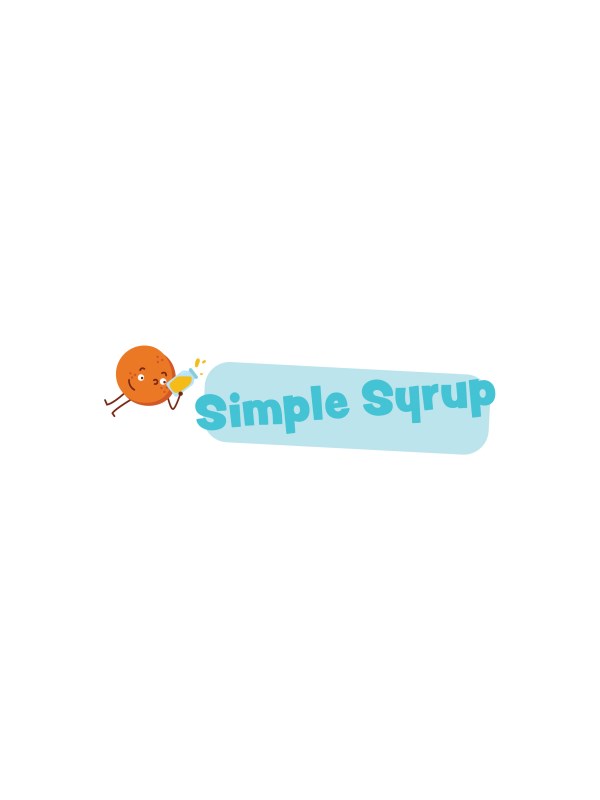
 MAKES 1 cup
MAKES 1 cup
TOTAL TIME 10 minutes for plain simple syrup, 40 minutes for flavored syrups
Adding sweetness and flavor to drinks couldn’t be “simpler” when you use this syrup! Make sure to use a jar that will still have some extra room in it after adding the water and sugar—you need space for the liquid to move around as you shake the jar. A pint- or quart-size jar works well.
Prepare Ingredients
⅔ cup sugar
⅔ cup water
1 flavor ingredient below (optional)
• 1 teaspoon grated lime zest plus 1 tablespoon juice
• 1 cup raspberries
• 1 cup quartered strawberries
• ½ cup pineapple chunks
• 1 cup mint leaves
• ½ cup chopped fresh ginger
Gather Cooking Equipment
Jar with tight-fitting lid
Fine-mesh strainer
Medium bowl
 Start Cooking!
Start Cooking!
1 In jar, combine sugar, water, and flavor ingredient, if using. Cover jar with lid to seal. Shake jar vigorously until sugar dissolves, about 2 minutes.
2 Let jar sit on counter until syrup turns clear, about 5 minutes. (If making a flavored syrup, let jar sit on counter for 30 minutes to infuse flavor.)
3 If making flavored syrup, place fine-mesh strainer over bowl. Remove lid from jar and pour syrup mixture through fine-mesh strainer. Discard solids in strainer. Pour flavored syrup back into jar. (Simple syrup can be refrigerated for up to 1 month.)

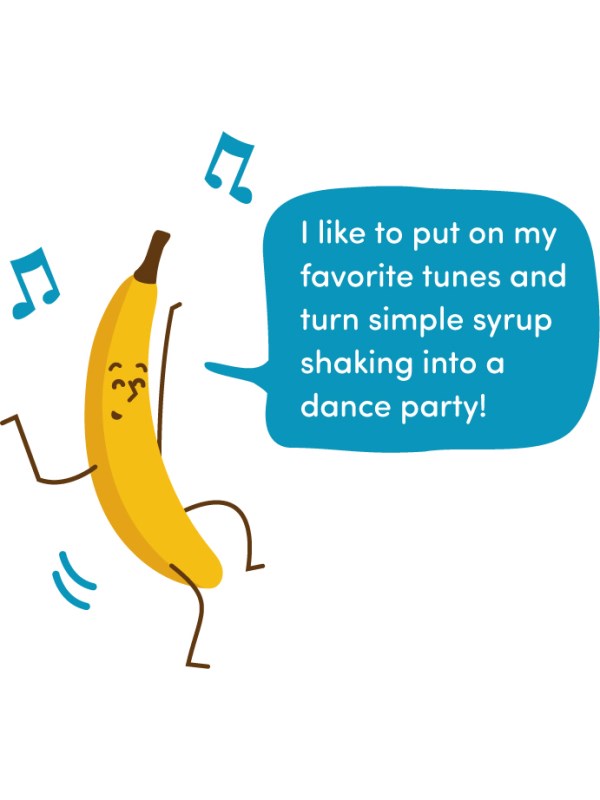
Food for Thought
This recipe uses two ingredients—sugar and water—that happen to be in two different states of matter. Matter is anything that takes up space. Our whole world is made of matter—people, animals, the ocean, food, air, houses, rocks, everything! Matter can exist in three different states: solid, liquid, or gas. Solids keep their shape, even if they move around. Bananas, elephants, and plates are solids—and so is sugar! The tiny sugar crystals keep their own shapes as they move around. Liquids don’t have their own shape; they take the shape of whatever container they’re in. Water, maple syrup, and shampoo are all liquids.

Look around your kitchen: Can you find other examples of solids and liquids?

 SERVES 1 (makes 1 cup)
SERVES 1 (makes 1 cup)
TOTAL TIME 45 minutes (including making Flavored Syrup)
If you’re making flavored seltzers for friends and family, mix them one glass at a time. A big batch needs a lot more stirring, which means you’ll lose those bubbles!
Prepare Ingredients
Ice
1 cup plain seltzer
1 tablespoon Flavored Syrup (see Simple Syrup recipe, this page)
Gather Cooking Equipment
Glass
Spoon
 Start Cooking!
Start Cooking!
Place ice in glass. Pour plain seltzer into glass over ice. Add Flavored Syrup and stir gently to combine. Serve.


Try it THIS Way!
Flavored Seltzer Combos Once you master the flavored syrups basics, play around with different flavor combinations. Try shaking up a few different flavored syrups (see the Simple Syrup recipe on this page for flavor ideas), and then mix and match them! Here are three of our favorite combinations.
STRAWBERRY-MINT SELTZER Use 2 teaspoons Mint Syrup and 1 teaspoon Strawberry Syrup per 1 cup of plain seltzer.
PINEAPPLE-LIME SELTZER Use 2 teaspoons Pineapple Syrup and 1 teaspoon Lime Syrup per 1 cup of plain seltzer.
RASPBERRY-GINGER SELTZER Use 1½ teaspoons Raspberry Syrup and 1½ teaspoons Ginger Syrup per 1 cup of plain seltzer.
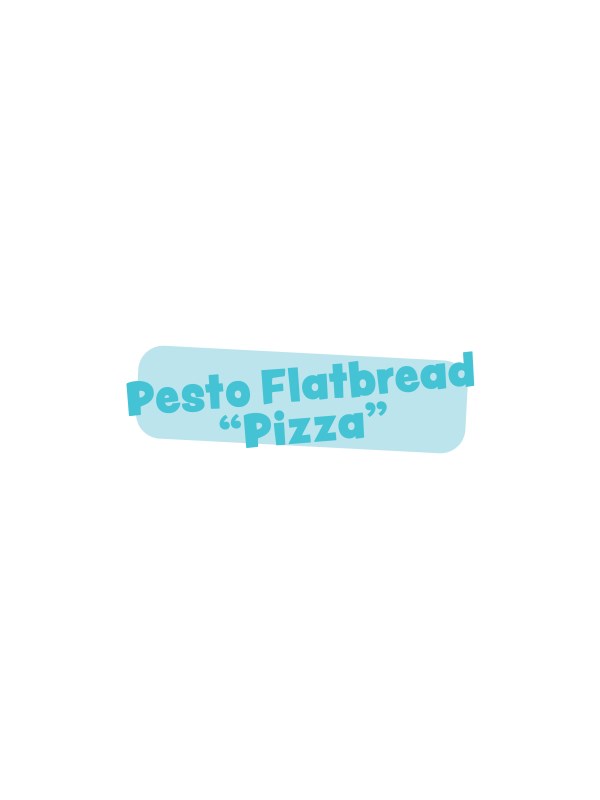

 SERVES 1 to 2
SERVES 1 to 2
TOTAL TIME 40 minutes
Prepare Ingredients
1 teaspoon extra-virgin olive oil
1 (8-inch) naan bread
2 tablespoons pesto
⅓ cup shredded mozzarella cheese
12 cherry tomatoes, cut in half
Gather Cooking Equipment
Pastry brush
Ruler
Rimmed baking sheet
Small spoon
Oven mitts
Cooling rack
Spatula
Cutting board
Chef’s knife or pizza wheel
 Start Cooking!
Start Cooking!
1 Adjust oven rack to lowest position and heat oven to 400 degrees. Use pastry brush to brush oil into 9-inch circle in center of rimmed baking sheet. Place naan on top of oil.
2 Use back of small spoon to spread pesto over naan, leaving ½-inch border around edge. Sprinkle cheese over pesto, then scatter tomatoes over cheese.
3 Place baking sheet in oven and bake until naan is golden brown around edges, 8 to 10 minutes.
4 Use oven mitts to remove baking sheet from oven (ask an adult for help). Place baking sheet on cooling rack and let cool for 5 minutes.
5 Use spatula to carefully transfer naan to cutting board (baking sheet will be hot). Use chef’s knife or pizza wheel to cut naan into wedges. Serve.

Food for Thought
Did you know that quick-cooking flatbreads, such as naan, are the oldest breads in the world? Humans have been making and eating flatbreads for thousands and thousands of years, since the late Stone Age.
Today, many cultures around the world have their own unique flatbread recipes. Here are a few flatbreads from across the globe. How many have you heard of? Have you eaten any of them? See if you can find each country or region on a world map.
Naan (India) Naan is a chewy flatbread that’s often eaten with stews and curries. It’s traditionally cooked on the hot surface of a special tandoor oven.
Tortillas (Mexico) Tortillas can be made from corn or wheat and are used in tacos, tostadas, enchiladas, and more.
Lavash (Armenia) Lavash is a soft, thin flatbread that’s usually rectangular. It can be rolled around fillings or baked into crisp crackers.
Pita (Middle East) People have been baking soft, tender pita bread—with its signature pocket—for thousands of years.
Injera (Ethiopia) Injera is a spongy flatbread made from a grain called teff. In Ethiopia, many dishes are served right on top of injera and people use pieces of the bread to pick up their food.
Fry Bread (North America, Native American) Fry Bread is a round, bubbly, fried dough (though different Native American tribes make different styles).
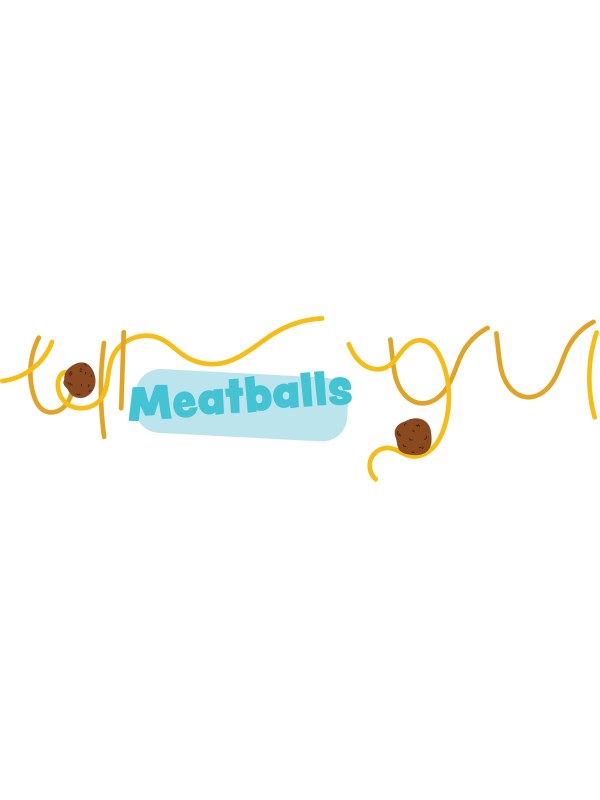
 SERVES 4 (Makes 12 meatballs)
SERVES 4 (Makes 12 meatballs)
TOTAL TIME 45 minutes
This recipe makes enough sauce to coat 12 ounces of pasta.
Prepare Ingredients
½ cup panko bread crumbs
½ cup milk
1 (28-ounce) can crushed tomatoes, opened
1 tablespoon extra-virgin olive oil
¼ teaspoon sugar
¼ teaspoon plus ½ teaspoon salt, measured separately
1 pound 85 percent lean ground beef
½ cup grated Parmesan cheese
½ teaspoon garlic powder
½ teaspoon dried oregano
Gather Cooking Equipment
Large bowl
Rubber spatula
Dutch oven with lid
1-tablespoon measuring spoon
Large plate
 Start Cooking!
Start Cooking!
1 In large bowl, add panko and milk. Use rubber spatula to stir to combine. Let mixture sit for 5 minutes.
2 In Dutch oven, combine tomatoes, oil, sugar, and ¼ teaspoon salt and stir with clean rubber spatula to combine.
3 Add beef, Parmesan, garlic powder, oregano, and remaining ½ teaspoon salt to bowl with panko mixture and mix together with your hands.
4 Divide beef mixture into 12 portions (about 3 tablespoons each) and place on plate. Use your slightly wet hands to roll each portion into ball.
5 Add meatballs to sauce in pot.
6 Bring sauce to simmer over medium heat. Cover and cook until meatballs are cooked through, 15 to 18 minutes, stirring halfway through cooking. Serve.

Food for Thought
While your meatballs cook, take a bite out of these meaty math problems.
If your family starts dinner with 12 meatballs and each person eats 2 meatballs for dinner, how many meatballs are left?
If you are serving meatballs to 6 people and each person wants 3 meatballs, how many meatballs do you need to make?
Your recipe makes 12 meatballs. If you want to save half of the meatballs for tomorrow, how many meatballs should you eat today?
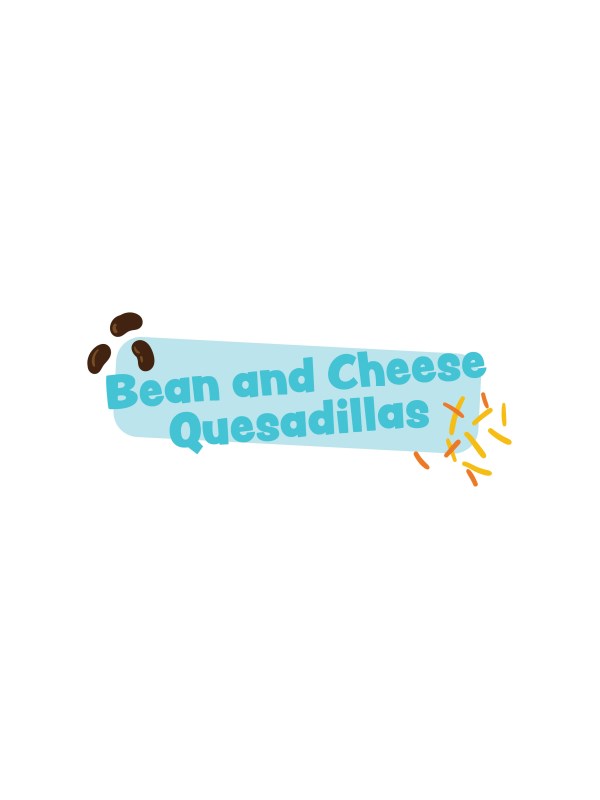

 SERVES 2
SERVES 2
TOTAL TIME 25 minutes
Eat these quesadillas plain or serve them with salsa, sour cream, and/or guacamole.
Prepare Ingredients
⅓ cup canned black beans
2 teaspoons plus 1 teaspoon extra-virgin olive oil, measured separately
2 (8-inch) flour tortillas
⅔ cup shredded Monterey Jack cheese
Gather Cooking Equipment
Colander
Medium bowl
Fork
Rimmed baking sheet
Pastry brush
Oven mitts
Cooling rack
Spatula
Cutting board
Chef’s knife
 Start Cooking!
Start Cooking!
1 Adjust oven rack to middle position and heat oven to 450 degrees. Set colander in sink. Pour beans into colander. Rinse beans with cold water and shake colander to drain well. Add beans and 2 teaspoons oil to bowl. Use fork to mash beans to chunky paste.
2 Place tortillas on rimmed baking sheet. Use pastry brush to paint tortillas with remaining 1 teaspoon oil. Flip tortillas over so oiled side is on baking sheet.
3 Use fork to spread half of bean mixture over half of each tortilla. Sprinkle cheese over bean mixture. Fold tortillas in half, forming half-moon shape, and press to flatten.
4 Place baking sheet in oven and bake quesadillas until spotty brown, 5 to 7 minutes.
5 Use oven mitts to remove baking sheet from oven (ask an adult for help). Place baking sheet on cooling rack and let quesadillas cool on baking sheet for 5 minutes.
6 Use spatula to transfer quesadillas to cutting board. Cut into wedges. Serve.

Food for Thought
While quesadilla might be a tough word to rhyme, lots of other words in this recipe are prime for a rhyme. How many words can you think of that rhyme with the words below? We added some examples for inspiration.



 MAKES 10 biscuits
MAKES 10 biscuits
TOTAL TIME 45 minutes, plus cooling time
Prepare Ingredients
2 cups (10 ounces) all-purpose flour
2 teaspoons baking powder
½ teaspoon baking soda
1 teaspoon sugar
¾ teaspoon salt
1 cup buttermilk
8 tablespoons unsalted butter, melted
Vegetable oil spray
Gather Cooking Equipment
Rimmed baking sheet
Parchment paper
Large bowl
Whisk
Liquid measuring cup
Fork
Rubber spatula
¼-cup dry measuring cup
Oven mitts
Cooling rack
 Start Cooking!
Start Cooking!
1 Adjust oven rack to middle position and heat oven to 450 degrees. Line rimmed baking sheet with parchment paper.
2 In large bowl, whisk flour, baking powder, baking soda, sugar, and salt until combined. In liquid measuring cup, use fork to stir buttermilk and melted butter until butter forms small clumps.
3 Add buttermilk mixture to bowl with flour mixture. Use rubber spatula to stir until just combined.
4 Spray inside of ¼-cup dry measuring cup with vegetable oil spray. Use greased measuring cup to scoop batter. Use rubber spatula to scrape off extra batter. Drop scoops onto baking sheet to make 10 biscuits (leave space between biscuits and respray measuring cup as needed).
5 Place baking sheet in oven and bake biscuits until tops are golden brown 12 to 14 minutes. Use oven mitts to remove baking sheet from oven (ask an adult for help). Place baking sheet on cooling rack. Let biscuits cool on baking sheet for 10 minutes. Serve warm.


Food for Thought
These light, fluffy biscuits get their name because you drop the batter onto the baking sheet. In this recipe, you used a ¼-cup dry measuring cup to scoop and drop 10 biscuits onto the rimmed baking sheet. Can you work backwards and figure out how many cups of biscuit batter you started with? Remember, there are four ¼ cups in 1 cup.



 SERVES 12
SERVES 12
TOTAL TIME 45 minutes, plus cooling time
If you don’t have a springform pan, you can use a 9-inch round cake pan instead (you’ll flip the cookie out of the pan just like a cake).
Prepare Ingredients
Vegetable oil spray
1 cup (5 ounces) all-purpose flour
¼ teaspoon baking soda
¼ teaspoon salt
8 tablespoons unsalted butter, melted
½ cup packed (3½ ounces) dark brown sugar
¼ cup (1¾ ounces) sugar
1 large egg
1 teaspoon vanilla extract
½ cup (3 ounces) chocolate chips
Gather Cooking Equipment
9-inch springform pan
2 bowls (1 large, 1 medium)
Whisk
Rubber spatula
Oven mitts
Cooling rack
Butter knife
Icing spatula or wide metal spatula
Cutting board
Chef’s knife
 Start Cooking!
Start Cooking!
1 Adjust oven rack to upper-middle position and heat oven to 375 degrees. Spray inside bottom and sides of 9-inch springform pan with vegetable oil spray.
2 In medium bowl, whisk together flour, baking soda, and salt.
3 In large bowl, whisk melted butter, brown sugar, and sugar until well combined. Add egg and vanilla and whisk until smooth.
4 Add flour mixture to large bowl with butter mixture and use rubber spatula to stir until just combined and no dry flour is visible, about 1 minute. Add chocolate chips and stir until evenly distributed.
5 Use rubber spatula to scrape cookie dough into greased springform pan and spread dough into even layer covering bottom of pan.
6 Place springform pan in oven and bake until cookie is golden brown and edges are set, 18 to 22 minutes.
7 Use oven mitts to remove springform pan from oven (ask an adult for help). Place springform pan on cooling rack and let cookie cool in pan for 30 minutes.
8 Run butter knife around inside edge of springform pan to loosen edges of cookie from pan. Unlock and remove side of pan. Use icing spatula or wide metal spatula to loosen bottom of cookie from pan and transfer cookie to cutting board. Cut cookie into wedges and serve warm.

Food for Thought
Your Giant Chocolate Chip Cookie makes enough for 12 servings. How will you cut the circle into 12 equal cookie wedges?

First, cut your cookie in half. How many equal pieces do you have?

Then, cut your cookie in fourths. How many equal pieces do you have now?

How will you turn ¼ of a cookie into 1/12 of a cookie? (Cut each ¼ into 3 equal pieces.)

 MAKES 12 cookies
MAKES 12 cookies
TOTAL TIME 30 minutes, plus cooling time
Be sure to use creamy peanut butter in this recipe—chunky peanut butter will result in cookies that won’t hold together as well.
Prepare Ingredients
½ cup (3½ ounces) sugar
1 large egg
½ cup creamy peanut butter
¼ cup M&M’S or Reese’s Pieces, or 12 Hershey’s Kisses
Gather Cooking Equipment
Rimmed baking sheet
Parchment paper
Large bowl
Whisk
Rubber spatula
1-tablespoon measuring spoon
Small spoon
Oven mitts
Cooling rack
Spatula
 Start Cooking!
Start Cooking!
1 Adjust oven rack to middle position and heat oven to 350 degrees. Line rimmed baking sheet with parchment paper.
2 In large bowl, whisk sugar and egg until smooth. Let mixture sit until sugar dissolves, about 5 minutes.
3 Add peanut butter to bowl and use rubber spatula to stir until smooth.
4 Use 1-tablespoon measuring spoon to drop 12 scoops of dough onto baking sheet, leaving space between scoops. (Dough is sticky so use small spoon to scrape from measuring spoon onto baking sheet). Gently press candies into tops of cookies.
5 Place baking sheet in oven. Bake cookies until edges are golden and tops are set, 10 to 12 minutes.

6 Use oven mitts to remove baking sheet from oven (ask an adult for help). Place baking sheet on cooling rack and let cookies cool on baking sheet for 10 minutes.
7 Use spatula to transfer cookies directly to cooling rack and let cool for 5 minutes before serving.

Food for Thought
If you’re using M&M’s or Reese’s Pieces in these cookies, you might be wondering how many candies to press into each cookie so that they’ll all have the same number? Math to the rescue! To find out how many candies to press into each cookie:
• First, count how many candies are in ¼ cup.
• Then, divide that number by 12 (the number of cookies you’ll make).
Don’t worry if the answer isn’t an even number—it’s OK if some cookies have more (or fewer) candies than others!
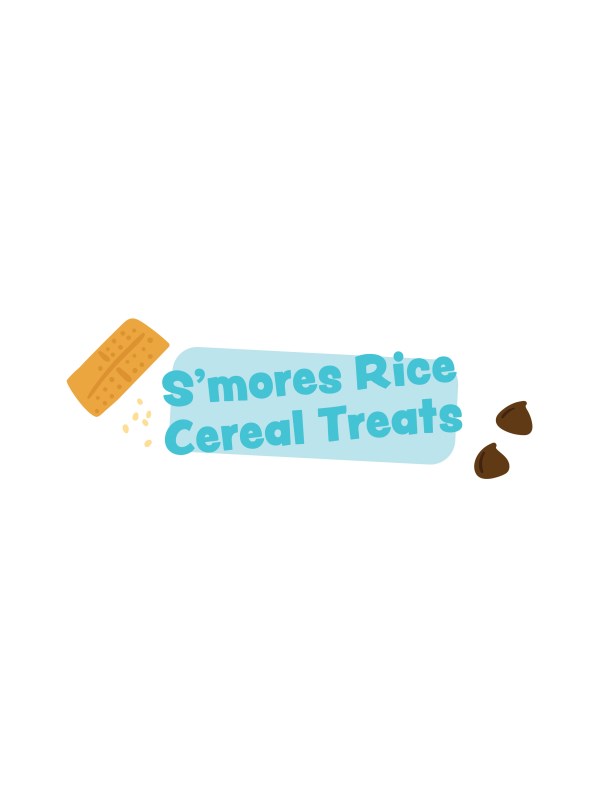

 MAKES 16 bars
MAKES 16 bars
TOTAL TIME 25 minutes, plus 1 hour setting time
Be sure to use large marshmallows in this recipe as mini ones won’t melt as well.
Prepare Ingredients
Vegetable oil spray
1 (10-ounce) package large marshmallows
4 tablespoons unsalted butter
1 teaspoon vanilla extract
⅛ teaspoon salt
5 cups (5 ounces) crisped rice cereal
½ cup (3 ounces) chocolate chips
3 whole graham crackers, broken into small pieces
Gather Cooking Equipment
8-inch square metal baking pan
Rubber spatula
Large microwave-safe bowl
Oven mitts
Butter knife
Cutting board
Chef’s knife
 Start Cooking!
Start Cooking!
1 Spray inside bottom and sides of 8-inch square metal baking pan well with vegetable oil spray. Spray rubber spatula with vegetable oil spray.
2 In large microwave-safe bowl, combine marshmallows, butter, vanilla, and salt. Heat in microwave until marshmallows are puffed, about 2 minutes. Use oven mitts to remove bowl from microwave. Use greased rubber spatula to stir until smooth.
3 Add cereal, chocolate chips, and graham cracker pieces to bowl. Stir until well combined. Scrape cereal mixture onto greased baking pan.
4 Lightly wet your hands and press cereal mixture into flat, even layer. Let sit at room temperature for 1 hour to set. Run butter knife around edge of cereal treats to loosen from baking pan. Flip cereal treats out of pan and transfer to cutting board. Cut into squares and serve.

Food for Thought
Rice Krispies, a type of crisped rice cereal made by the Kellogg’s company, is one of the most popular types of cereal on supermarket shelves—and a key ingredient in this recipe. Rice Krispies cereal was invented in 1927, but according to legend, Rice Krispies Treats weren’t invented until the 1930s when Mildred Day, a Kellogg’s recipe tester, combined marshmallows and the crisped rice cereal. Originally called “marshmallow squares,” Kellogg’s printed the recipe for the new treat on its Rice Krispies cereal box for the first time in 1941. Families have been making and eating them ever since!
Imagine you are an inventor like Mildred Day. Can you imagine a new treat that uses breakfast cereal as an ingredient? Draw a picture of your idea in the box at right and think of a name for it.
What type of cereal would you use in your recipe?
What other ingredients would your treat have?
If you’re feeling adventurous, try to make a batch of your new treat and do a taste test with your family!
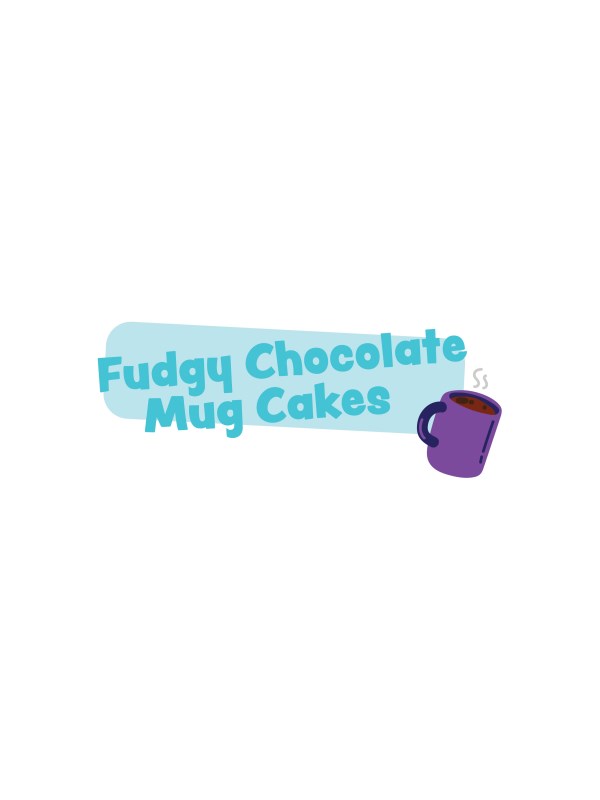
 SERVES 2
SERVES 2
TOTAL TIME 30 minutes
These cakes “bake” for just a few minutes in the microwave!
Prepare Ingredients
¼ cup (1¼ ounces) all-purpose flour
½ teaspoon baking powder
4 tablespoons unsalted butter, cut into 4 pieces
3 tablespoons chocolate chips
2 large eggs
¼ cup (1¾ ounces) sugar
2 tablespoons cocoa powder
1 teaspoon vanilla extract
⅛ teaspoon salt
Gather Cooking Equipment
2 bowls (1 small, 1 medium microwave-safe)
Whisk
Spoon
2 coffee mugs (at least 11 ounces each)
Oven mitts
 Start Cooking!
Start Cooking!
1 In small bowl, whisk together flour and baking powder.
2 In medium microwave-safe bowl, combine butter and chocolate chips. Heat in microwave at 50 percent power for 1 minute. Open microwave and stir mixture with spoon. Continue to heat in microwave at 50 percent power until melted, about 1 minute. Remove bowl from microwave.
3 Add eggs, sugar, cocoa, vanilla, and salt to medium microwave-safe bowl with chocolate mixture and whisk until smooth.
4 Add flour mixture and whisk until smooth. Use spoon to divide batter evenly between 2 coffee mugs.
5 Place mugs on opposite sides of microwave turntable. Cook in microwave at 50 percent power for 1 minute. Open microwave and use spoon to stir batter in each mug, making sure to reach bottom of mug.
6 Cook in microwave at 50 percent power for 1 minute (batter will rise to just below rim of mug and cake should look slightly wet around edges—if top still looks very wet, cook in microwave at 50 percent power for another 15 to 30 seconds).
7 Use oven mitts to remove mugs from microwave and let cool for 5 minutes. Serve warm.

Food for Thought
You’ve probably popped popcorn or heated up food (and now baked a cake!) in the microwave. But have you ever wondered how microwave ovens work?
Microwave ovens generate invisible electromagnetic waves (called…microwaves!). Those microwaves make water molecules heat up. And there’s a lot of water in food. Wherever the microwaves strike the food, the water molecules heat up. That heat spreads from one part of the food to other parts—usually from the outside to the inside—heating up more of the food over time. You can see this in action as you “bake” your mug cakes in the microwave.
1 Observe your mug cake before you put it in the microwave. Is it liquid or solid?
2 Observe your mug cake when you stir the batter in step 5. Is it liquid? Solid? Or a combination? Does it look different before and after you stir?
3 Observe your mug cake one more time, right before you eat it. Is it liquid? Solid? Or a combination?
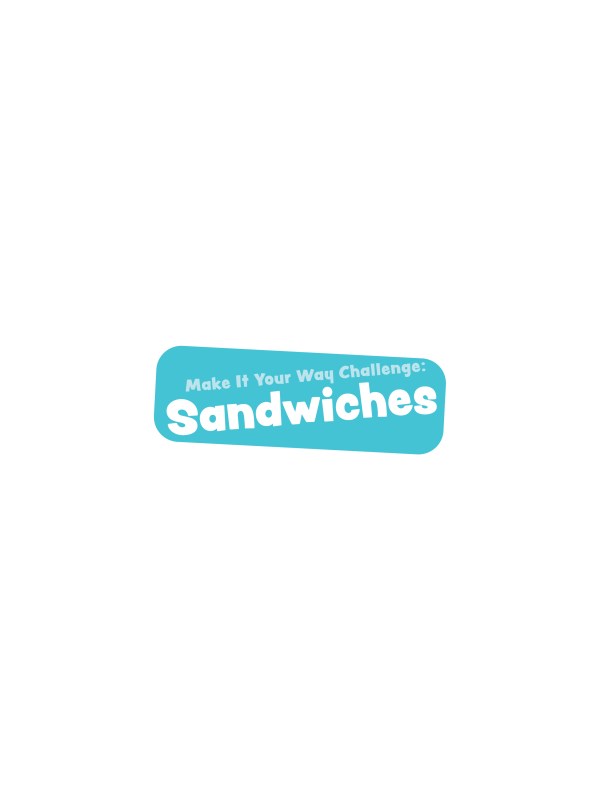
The sandwich was invented in England almost 300 years ago, when the fourth Earl of Sandwich, a member of the British nobility, was too busy to sit down to a meal. Instead, he asked to be served slices of cold beef between two pieces of bread…and the rest is sandwich history. Today, you hold the reigns of sandwich power: Design YOUR dream sandwich. One that you’d be excited to eat for lunch. (Or dinner, or breakfast—it’s always a good time for sandwiches!) The only rule? It’s got to have bread and fillings. Otherwise, the sky’s the limit.
To ignite your imagination, think about the different parts of a sandwich:
The Bread
What will you use for the outside of your sandwich? There are so many options: pillowy sandwich bread, chewy sourdough, a pita pocket, a lavash wrap, even a tortilla! Will you toast your bread or leave it plain? Will your sandwich be closed- or open-face?

The Filling
What will be your main filling? Will you go traditional with sliced turkey, ham, or cheese? Add leftovers, such as grilled chicken, meatballs, or falafel? Or will you use a creamy spread, such as hummus or peanut butter? You could even use scrambled eggs to make a breakfast sandwich!
The Extras
What will you use to add more flavors and textures to your sandwich? Smooth mayonnaise or sliced avocado? Tangy barbecue sauce? Spicy mustard? Some crunch from shredded carrots, cooked bacon, or a few potato chips? A bit of sweetness from jam or honey?



Salt is an amazing ingredient. Not only does salt have its own taste (put a few grains on your tongue—what does it taste like?), it also amps up the flavor of just about any food it’s added to.
Today your task is to discover what foods taste even better with a sprinkle of salt. Explore your pantry, refrigerator, freezer, or garden and gather foods that you think might taste better with some salt. Look for some savory foods and some sweet ones. Take a bite or sip of each food without salt. Then, taste again after you add some salt. How does the flavor change? Don’t be afraid to try something totally wacky—you never know what will taste better with a few flakes of salt!

Salt Sources
Try sprinkling coarse sea salt (or even kosher salt) on different foods. Then, take a taste. How does adding salt change the food’s flavor? You can even try adding a dash of a salty condiment, such as soy sauce or Worcestershire sauce.
Here are some ideas to spark your salty exploration:
FRUITS Watermelon, honeydew, peaches, grapefruit, mangos, berries
VEGETABLES Tomatoes, potatoes, radishes, broccoli, corn on the cob
GRAINS & BREADS Rice, pasta, buttered toast, oatmeal, popcorn
PROTEINS Eggs, steak, salmon, nuts, nut butter
DAIRY Butter, pudding, yogurt, cheese, ice cream
SWEETS Chocolate bars, cookies, caramel sauce, pies, frosting
BEVERAGES Fruit juice, hot cocoa, smoothies


It’s fun to experience different textures when you’re eating a meal or even a single bite of food: smooth yogurt with crunchy granola, creamy ice cream with gooey hot fudge, tender pancakes with sticky maple syrup…and on and on and on!

Can you create a snack or meal that includes at least THREE different textures? You can make something savory (such as a sandwich or salad), or something sweet (like an ice cream sundae). Breakfast, lunch, dinner, snack, dessert—anything goes! See what foods you already have in the pantry or refrigerator, or ask an adult to help you visit the grocery store.
Here are some suggestions to help you brainstorm different texture combinations:
SMOOTH Yogurt, tomato soup, mashed potatoes, avocado
MOIST Strawberries, banana bread, chocolate cake, tomatoes, watermelon, pound cake
STICKY Honey, jam, maple syrup, caramel sauce, peanut butter
CRUNCHY Cereal, apples, fried chicken, nuts, pretzels, granola, celery
DRY Dried herbs, toasted bread, popcorn, saltines
CREAMY Ice cream, Brie cheese, mayonnaise, pudding
CRISPY Cooked bacon, romaine lettuce, potato chips
CHEWY Brownies, beef jerky, gummy candies, al dente pasta, caramel candies
CRUMBLY Shortbread cookies, corn on the cob, biscuits, rice, feta cheese
SOFT Hamburger buns, marshmallows, dinner rolls, muffins, bananas
TENDER Braised meat, mozzarella cheese, cooked beans, pancakes
CHUNKY Vegetable soup, chili, cottage cheese, guacamole, salsa

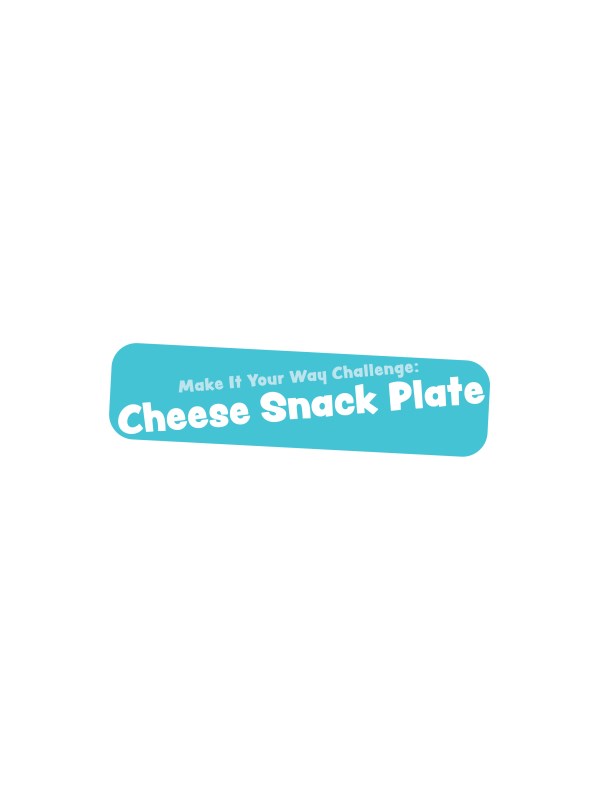
Cheese and crackers are a classic snack pairing. They’re also a blank canvas that lets your imagination run wild.
Today we challenge you to create your ideal cheese snack plate! It can be small or large, sweet or savory—or both! Put together a plate full of different colors or stick with one hue and make it monochrome (why not!?). Mix and match flavors and textures: creamy, crunchy, salty, gooey, crispy, nutty, sweet…see if you can build a different combination for every bite!
To inspire your cheesy brainstorming, think about the three things that most cheese plates have:
The Base
What will you put your cheese on top of? Usually this is something crispy or crunchy, such as crackers, pita chips, or even potato chips. You could also use something sweet, such as slices of fresh fruit or even a waffle or pancake!
The Cheese
You can’t have a cheese snack plate without cheese! If you want to include more than one cheese, try using cheeses with different textures, such as a hard cheddar and a soft Brie.

The Extras
Add layers of flavor and texture (and color!) to your snack plate with one or more extras. Will you try something sweet, such as fruit, honey, or jam? Something savory, such as sliced ham or salami? Sour pickles? Crunchy nuts? Fresh herbs? Spicy salsa? Anything goes!